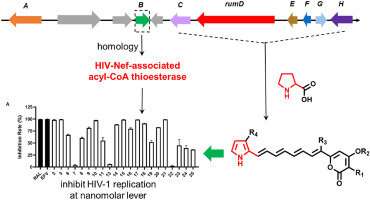
In a new article from Acta Pharmaceutica Sinica B, authors Beifen Zhong, Jun Wan and colleagues from the Chinese Academy of Medical Sciences & Peking Union Medical College, Beijing, China, discuss biosynthesis of rumbrins and inspiration for discovery of HIV inhibitors.
Investigation on how nature produces natural compounds with chemical and biological diversity at the genetic level offers inspiration for the discovery of new natural products and even their biological targets.
The polyketide rumbrin is a lipid peroxide production and calcium accumulation inhibitor, which contains a chlorinated pyrrole moiety that is a rare chemical feature in fungal natural products.
The authors of this article identify the biosynthetic gene cluster (BGC) rum of rumbrin and its isomer 12E-rumbrin from Auxarthron umbrinum DSM3193, and elucidate their biosynthetic pathway based on heterologous expression, chemical complementation, and isotopic labeling. It is demonstrated that rumbrins are assembled by a highly reducing polyketide synthase (HRPKS) that uniquely incorporate a proline-derived pyrrolyl-CoA starer unit and followed by methylation and chlorination. Sequent precursor-directed biosynthesis was able to yield a group of rumbrin analogs.
Source: Read Full Article






